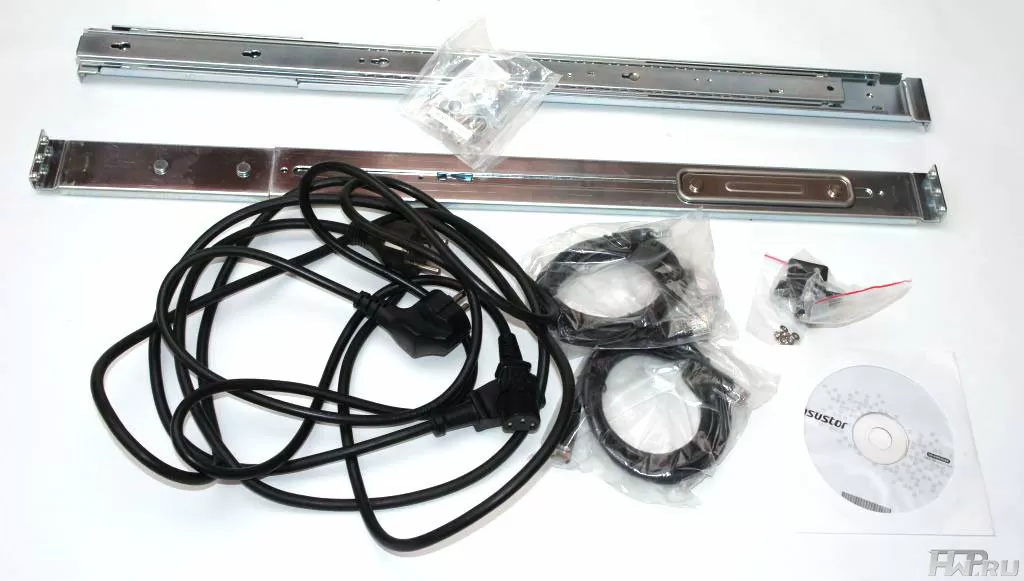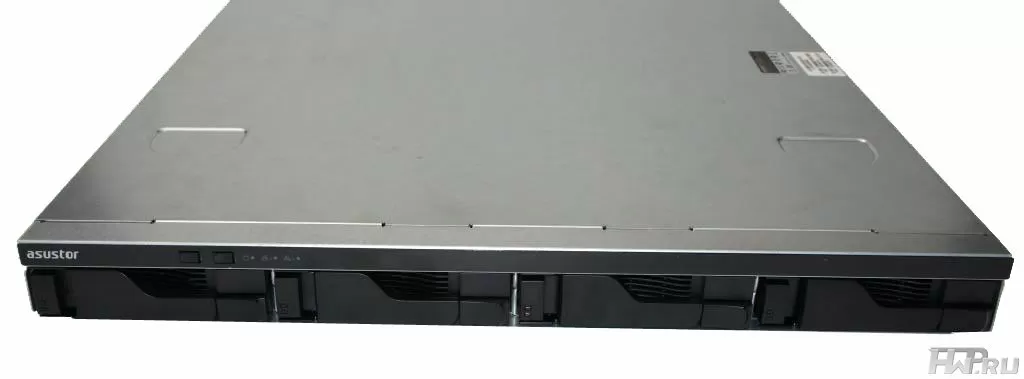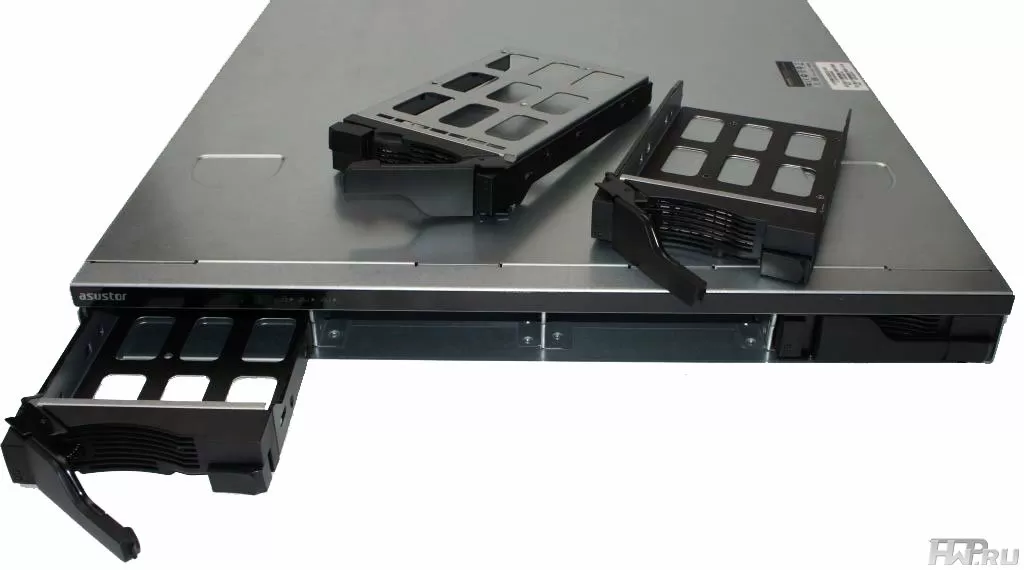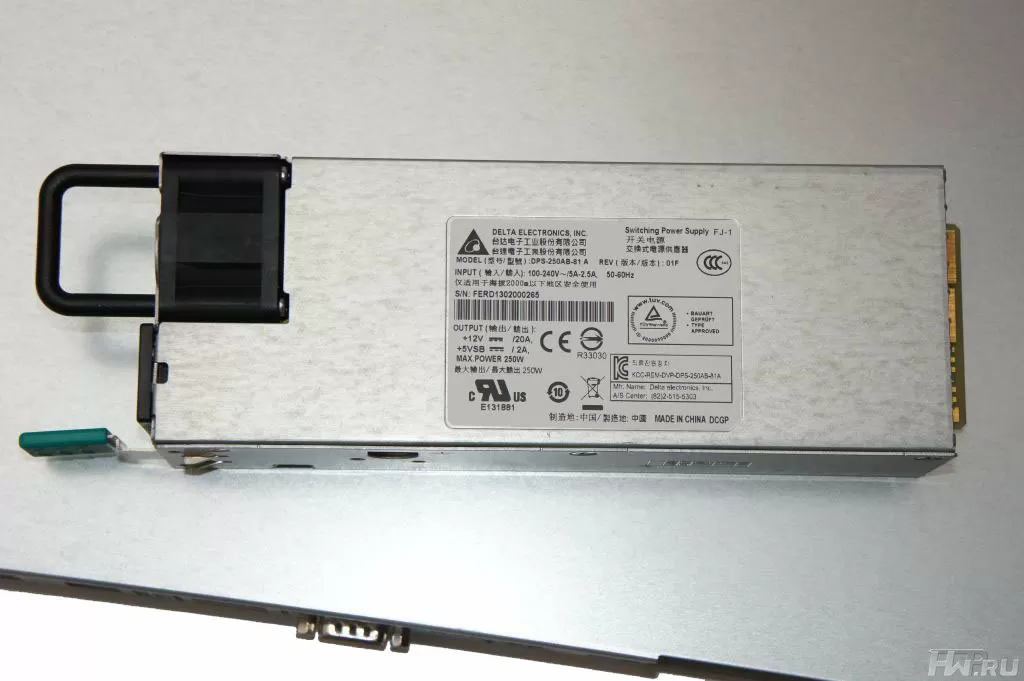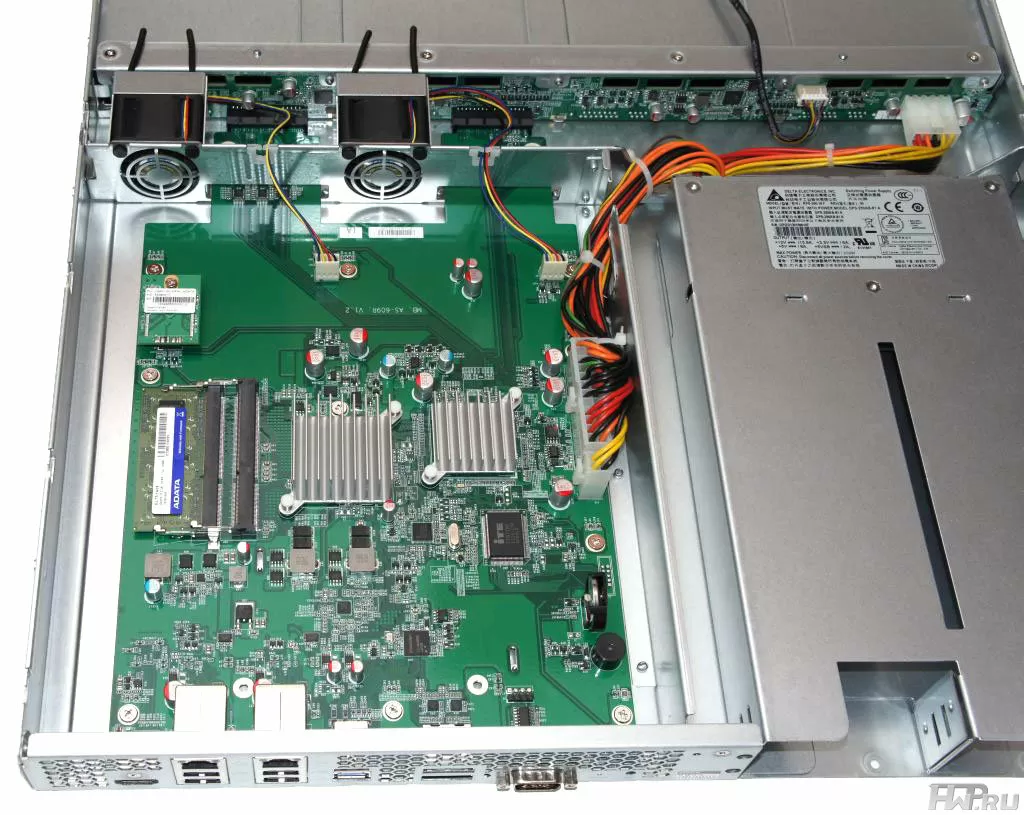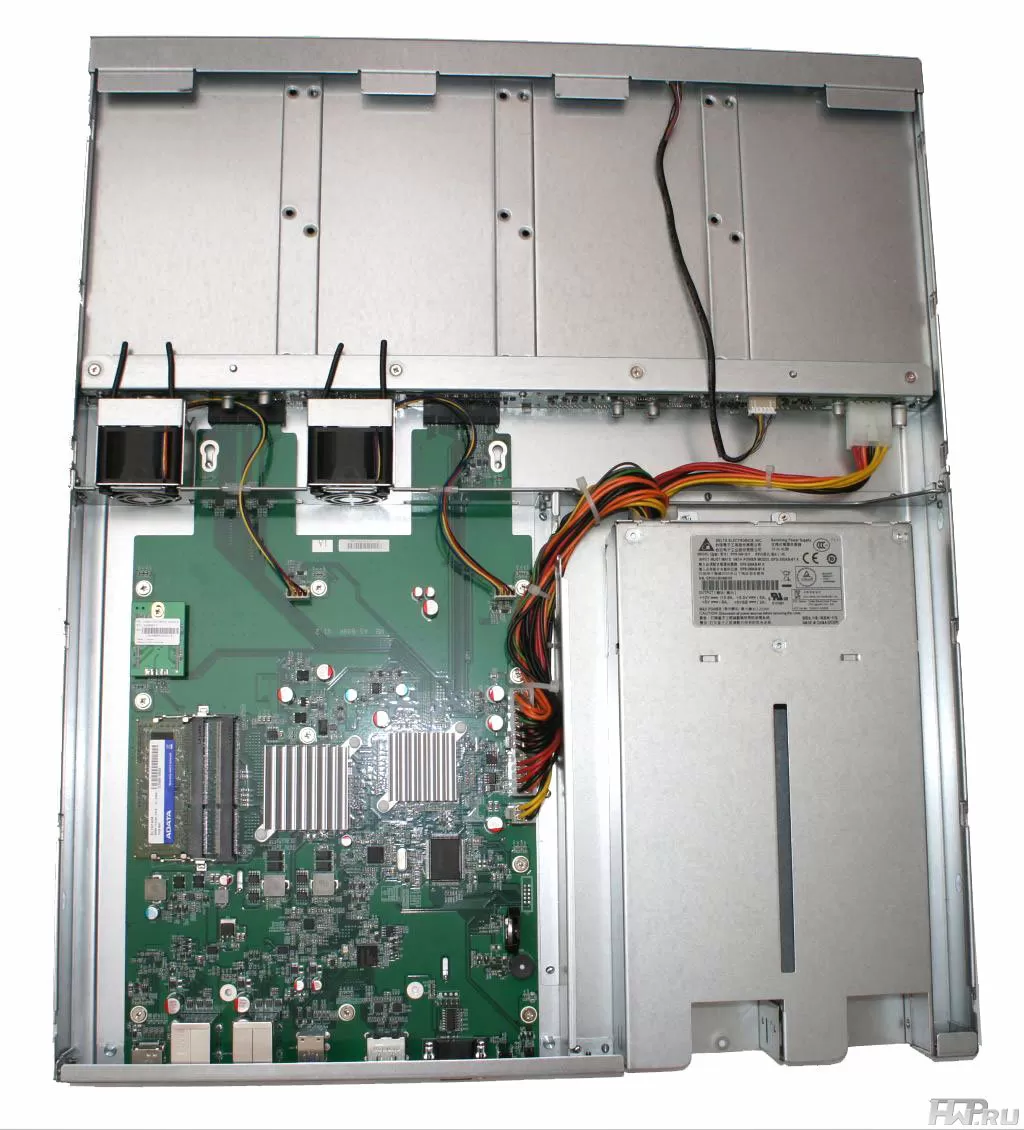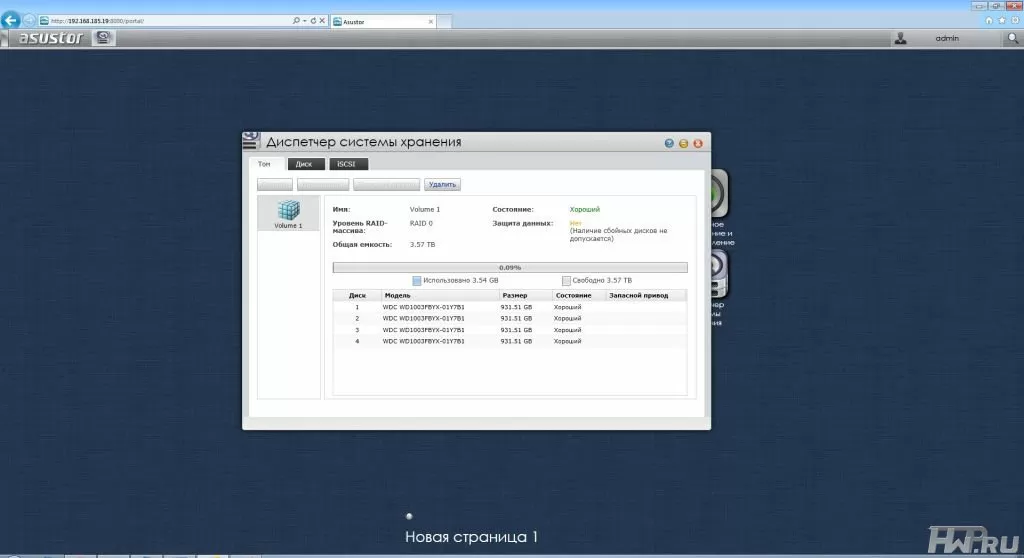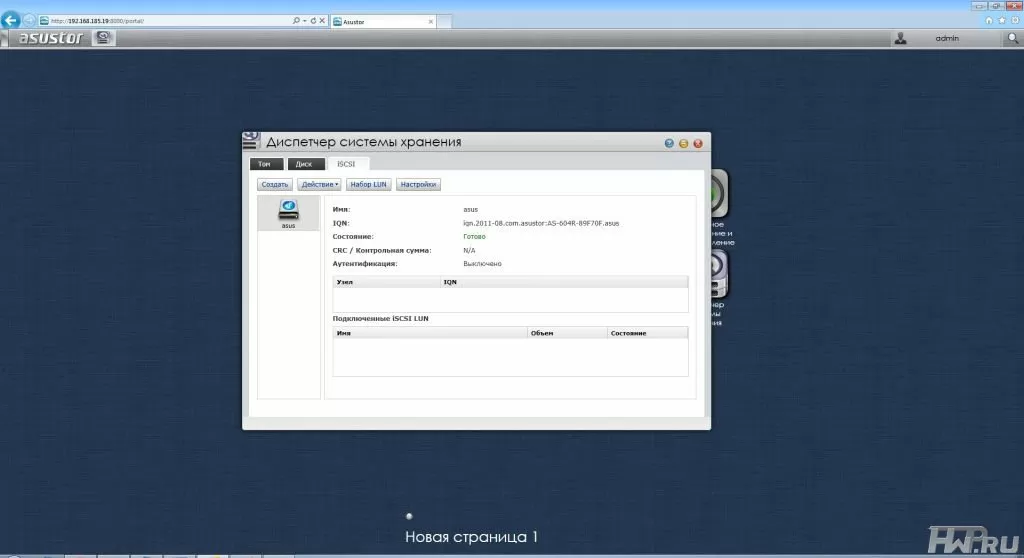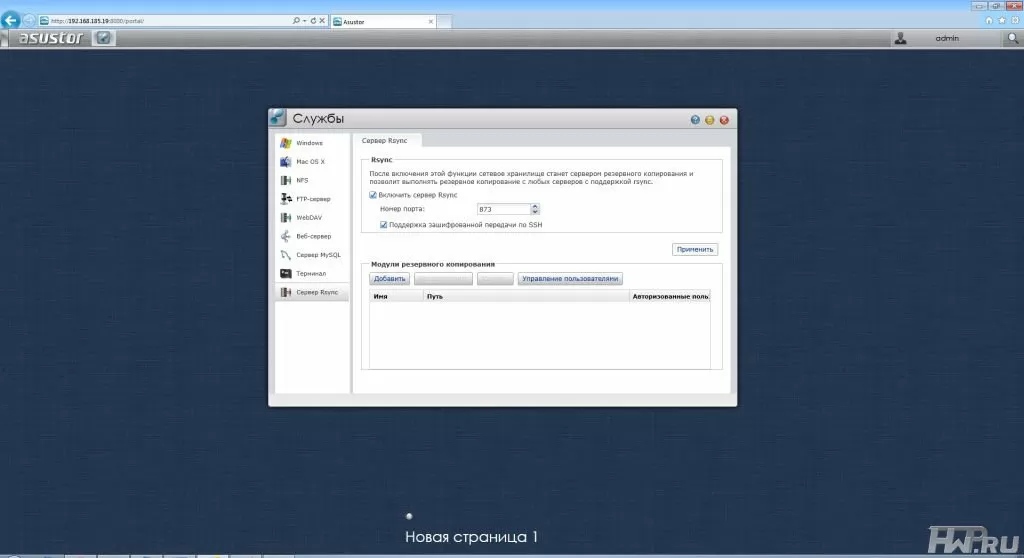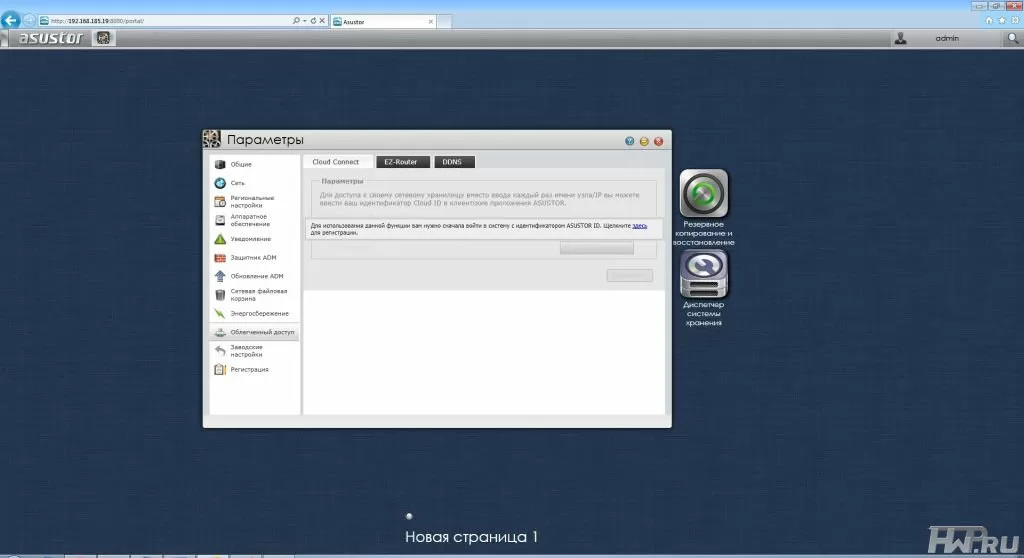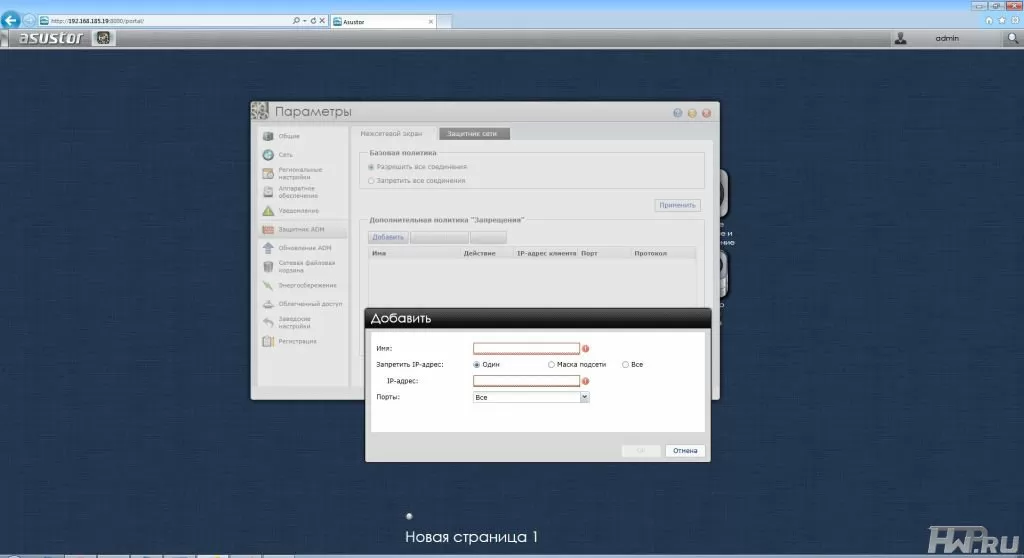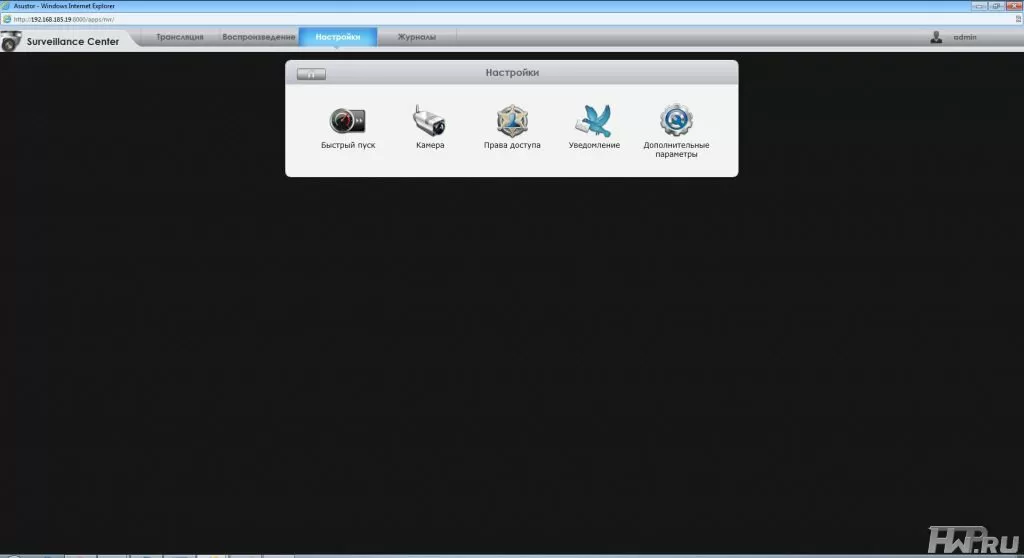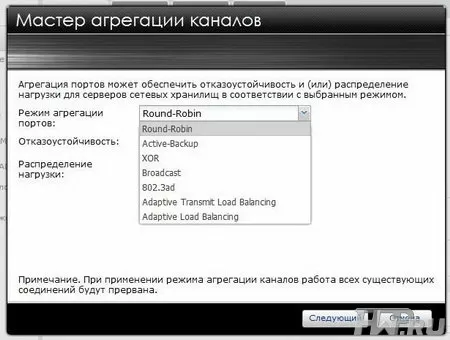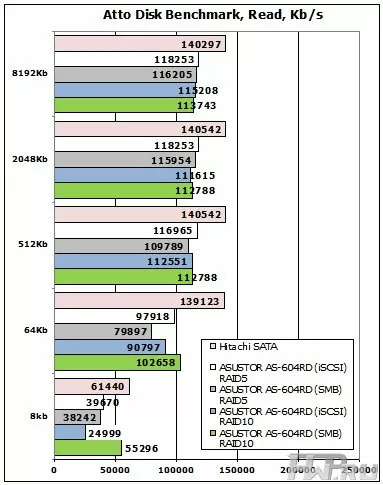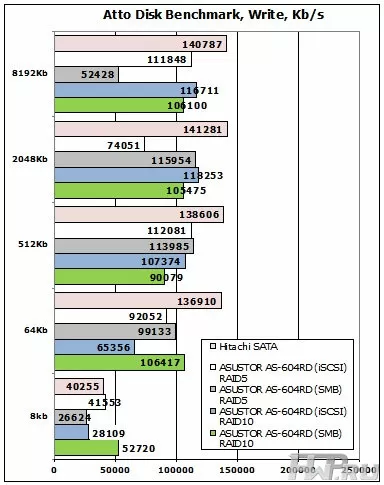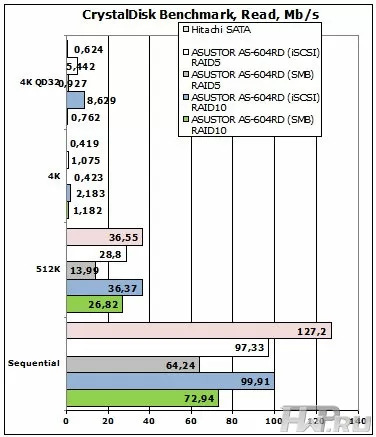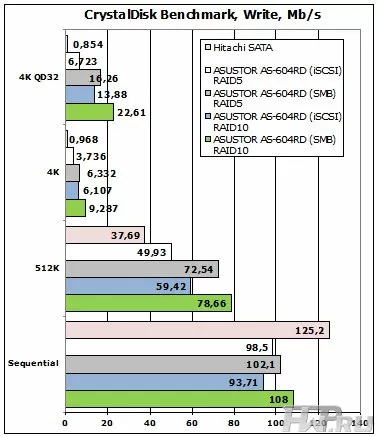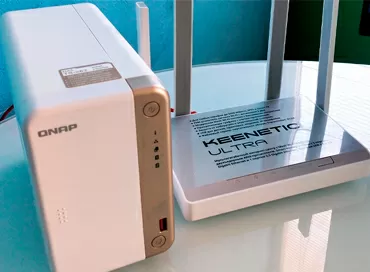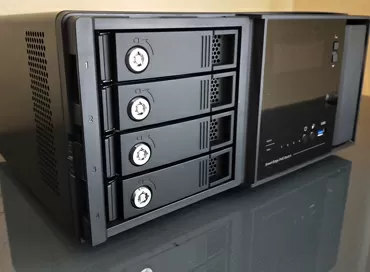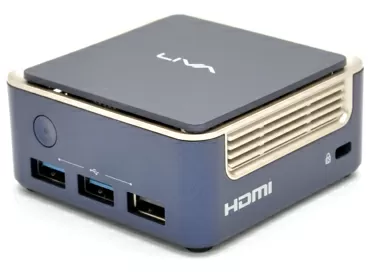ASUSTOR AS-604RD storage system review
The issue of organizing data storage in small and medium businesses often causes headaches. How many issues need to be resolved, how many requests need to be satisfied at the same time, and at the same time the system must work in 24x7 mode with minimal support from IT specialists. There are many solutions, and one of them is buying a ready-made NAS file server for multiple drives. Today we are going to take a look at the entry-level solution for four 1U drives for installation in a cabinet or rack - the ASUSTOR AS-604RD. As a reminder, recently we got acquainted with the home storage ASUSTOR AS-606T , and it pleasantly surprised us. Now let's see what this manufacturer can offer for the corporate segment.
Package contents
The file server comes in a decent sized package, so when you buy it is better to order the delivery with the rise to the floor.
The manufacturer equips some server modifications with skids, corners, a set of fasteners, two power cables, two network cables and a software disk. I would like to emphasize that the skids are made on ball bearings, which is highly appreciated. But the presence of a sled must be checked before ordering, because by default ASUSTOR AS-604RD is not equipped with them.
Specifications ASUSTOR AS-604RD
- Hardware Specification
- Processor: Intel & reg; Atom ™ 2.13 GHz Dual-Core Processor
- Memory: 1GB SO-DIMM DDR3 (Expandable. Max.3GB)
- Hard Drive: 2.5 " or 3.5 " SATA II/III x 4
- Expansion: USB 3.0 x 2, USB 2.0 x 4, eSATA x 2
- Network: Gigabit Ethernet x 2
- Output: HDMI x 1
- Fan: 40mm x 1
- Input voltage: 100V to 240V AC
- Certificate: FCC, CE, VCCI, BSMI, C-TICK
- Operation
- Power consumption:
- AS-604RS: 41.8W (Operation); 31.6W (Disk Hibernation); 1.4W (Sleep Mode)
- AS-604RD: 49.8W (Operation); 37.5W (Disk Hibernation); 6.42W (Sleep Mode)
- Noise level:
- Working temperature: 5 ° C ~ 35 ° C (40 ° F ~ 95 ° F)
- Humidity: 5% to 95% RH
- Size and weight
- Size: 45.5 (H) x 515 (W) x 439 (D) mm
- Weight: 9.3 Kg/20.5lb
The device is almost 440 mm deep, which is compact enough for installation in a wall cabinet.
Appearance and structure of ASUSTOR AS-604RD
Getting to know the design of 1U equipment is not a tricky business. Where can you run up here? Moreover, we are talking about a four-disk file server.
ASUSTOR AS-604RD front panel is not loaded with unnecessary elements. Four bays for HDD, a couple of buttons and three indicators. Everything. And this is its beauty - for example, the second button (the first one is understandably `` Power '') turns on the LED indicator (`` beacon '') in the front and back, so that it will be easier to find the NAS from the back of the cabinet among many other network equipment.
Indicators display the storage status as a whole and the operation of network interfaces.
Each HDD bay also has two indicators, which can be used to determine the status of the work and the status of the hard disk. The slide is made of very high quality, the front panel is plastic, but the latch mechanism itself is metal. The trays for the HDD are fixed clearly, they open and close quite easily. It is possible to install both 3.5 and 2.5 inch HDD and SSD.
At the back, all the space is given to the interface ports, but at the same time, every free square centimeter of the area is "given" under ventilation.
The port selection is quite predictable: two modern USB 3.0 ports, four USB 2.0 ports, two eSATA, two RJ45 network ports, one HDMI video output and a console COM port.
The storage is powered by two DELTA Electronics 250 W power supplies each. Considering that the power consumption of the server will be in the region of 50-60 W, the power supply is huge here.
The layout of the internal space is quite typical: the motherboard takes up a quarter of the internal space. There are only two radiators, and even those are of very modest size, because the modern Atom platform is a model of low power consumption, so even at the most atrocious electricity tariffs, the presence of Asustor AS-604RD will not affect electricity bills.
Cooling is based on the classic front-to-back arrangement: cold air is drawn in from the front through the hard disks, and hot air is expelled from the back. However, the location of the fans is not as simple as usual. One pair of hard drives (along with the motherboard) is driven by two system fans (installed in the immediate vicinity of the hard drive cages), and through the other, the fans of the power supplies (located directly at the rear). But if we take into account that the system does not work without power supplies, that is, at least one power supply unit will work, then the second pair of hard drives will never be left without cooling. At the same time, it should be borne in mind that an increase in the number of fans will inevitably lead to an increase in noise and energy consumption. Therefore, the manufacturer has found such an interesting way out.
What else interests us? Of course - a free RAM slot. The first has a 1 Gb memory bar manufactured by ADATA. Many models boast 2 GB of on-board memory, but in fact, modern NAS operating systems actually require much less, and even 1 GB is enough for them. But if there is an urgent need - you can buy one more bar and increase the amount of memory yourself
The first impression of ASUSTOR AS-604RD is not bad: a simple but functional front panel (for the rack-mountable version - what you need), two power supplies - everything is at the level, there is nothing to complain about. Perhaps, it would be nice to have a USB port on the front panel with a quick copy button. So, just in case. But what is not, that is not.
ASUSTOR AS-604RD Features
Speaking about the pricing of network storages, many for some reason forget that in the case of buying a NAS, they pay not only (we would even say "not so much") for "hardware", but also for software. After all, buying a laptop with a preinstalled licensed OS, already at a subconscious level, it works that money is paid not only for the laptop itself, but also for the license. And many, trying to save money, are looking for models without an OS at all (well, or with pre-installed free MS DOS or Linux). And in the discussion of the cost of file servers, for some reason, many do not take this moment into account. But the beauty of a ready-made NAS solution lies precisely in the fact that entire departments of programmers and developers have spent thousands of hours so that the NAS user does not waste time and energy on maintaining and maintaining the storage.
In the case of a regular server, even to raise a simple file exchange system, you need to install the OS, spend time configuring both the OS and the corresponding services. At the same time, the operating systems of the Windows family, in fact, cannot boast of stability and complete absence of errors, and Linux, despite its stability and functionality, requires a certain qualification and knowledge base not only for deployment, but also for subsequent maintenance. By making a choice in favor of network storages with a proprietary OS, both the employer and the employee who will accompany such a product wins. And the benefit lies in the fact that labor costs (including temporary) for maintaining a NAS are an order of magnitude less than for maintaining file servers based on Windows/Linux. Yes, take at least the very first action - commissioning. How long will it take to deploy a new file server? Few hours. And it takes about 10 minutes to start up and initial setup of the NAS. Is there a difference?
It should be noted that the OS itself is not stored on the built-in memory, but directly on hard disks (to be precise, on the main volume). But a FLASH drive is connected to the motherboard, which stores the OS image (for deploying the OS without using CDs or a file with firmware, as was previously required on inexpensive NAS). So if you remove all four HDDs and install others, you will have to reinstall the OS. But for such situations, it is possible to save and load the configuration, so this may not be considered a special drawback.
In the review of ASUSTOR AS-606T, we briefly got acquainted with the ADM 1.0 (ASUSTOR Data Master) operating system, now we will try to touch upon those moments that allow ASUSTOR AS-604RD to look worthy on the corporate solutions market. After all, ASUSTOR AS-604RD, as we have already noted, is designed exclusively for office use.
After entering the login and password, the user is redirected to the main menu. In terms of convenience, color and functionality, ASUSTOR's OS (ADM 1.0) easily matches the market leaders (represented by Synology and QNAP). There is a virtual desktop and support for multi-window mode. Perhaps there are not enough widgets with system information, but this is nitpicking.
What's important for the office? Of course, reliability and fault tolerance. Almost any of the current RAID arrays can be built on four hard drives: RAID0/1/5/6/10, as well as JBOD.
Also, the corporate server must be able to integrate with the Windows domain. After entering ASUSTOR AS-604RD into the domain, access to file resources can be differentiated by domain accounts and security groups.
Thanks to the support of all current protocols (CIFS/SMB, FTP, WebDAV, NFS, AFP), the NAS is compatible with all existing devices, from Windows PCs, Linux, Apple products with Mac OS OS, ending with mobile devices based on Android, and even regular phones equipped with web browsers.
So there will be no problem with the user equipment.
But for server equipment, high-quality iSCSI support is much more important. ASUSTOR AS-604RD supports a wide variety of iSCSI functions, from displaying and masking LUNs, mounting ISO images, to persistent (SCSI-3) backups, and iSCSI MCS support will appear in June. The AS-604RD is also fully compatible with VMware, Citrix and Hyper-V virtualization environments.
For backup implementation, ASUSTOR AS-604RD can act as both terminal and Rsync server. The NAS can be used both as a backup storage, and vice versa - to back up information from it to external devices. Thus, AS-604RD can be used as an intermediate link - save information from local PCs, and then back up this data to a central file server (or to the cloud, or wherever).
Even if ASUSTOR AS-604RD is used as the only server in the infrastructure (suppose it is a very small branch with a minimum number of users and network equipment), there is a whole list of functions that will solve many pressing problems. For example, using the proprietary Cloud Connect service (in fact, this is an analogue of DDNS, but the essence of the matter does not change), you can `` lay out '' access to the storage from the global Internet, that is, from anywhere on the planet (where there is Internet access, of course). Thus, remote management can (and should) be used to maintain the storage and provide timely maintenance. Since these services have ceased to be paid, its own service from the manufacturer is a good idea.
For security reasons, there is a built-in firewall hidden behind the name "ADM Defender". Using it, you can block access to the NAS from specific IP addresses, or block access when an attempt is detected to brute-force a password to any of the services (whether it is access to file resources via the SMB protocol or an attempt to hack the Web interface).
Thanks to customizable rules, you can provide any necessary protection (relevant to your environment).
You can expand the functionality of ADM 1.0 by installing applications from "App Central". Almost a hundred applications for various purposes - from multimedia services (for example, iTunes), ending with various photo galleries, blogs, Joomla, SQL, WordPress and others and more. But in an office environment, the Surveillance Center is much more useful. - IP camera control center. It can be used to organize video surveillance. Of course, with the possibility of video recording, with all kinds of notifications via e-mail, SMS messages. A complete IP video surveillance server. True, the list of supported models of IP cameras is not very wide today, but work in this direction is ongoing. But unlike its competitors, ASUSTOR is immediately equipped with four licenses (for connecting four cameras).
Another important issue for a mid-sized office environment is network connectivity. Two gigabit interfaces can be used to either connect the NAS to two different subnets at the same time, or use the link aggregation wizard to achieve fault tolerance and/or load balancing. The following port aggregation modes are available in ADM 1.0: Round-Robin, Active-Backup, XOR, Broadcast, 802.3ad, Adaptive Transmit Load Balancing, and Adaptive Load Balancing. Of course, keep in mind that the network equipment to which the NAS will connect must also support port aggregation. For example, 802.3ad, when configured on both the NAS and the switch, ensures even traffic using the bandwidth of both ports.
In XOR mode, a specific channel is allocated for each hardware address (MAC), which ensures load balancing on each port and high fault tolerance. But TLB (Adaptive Transmit Load Balancing) and ALB (Adaptive Load Balancing) no longer require a special switch. TLB allows you to distribute outgoing traffic to each network connection in accordance with the current load. And all incoming traffic goes to the `` receiving '' network interface (if it fails, the second interface becomes the `` receiving one ''). In ALB, balancing is achieved through the use of ARP (Address Resolution Protocol). The connector driver intercepts the ARP responses sent by the local system and changes the hardware address to a unique address for one of the Ethernet ports so that each user uses a different hardware address. Load Balance also balances outbound traffic by accepting inbound traffic from any active port.
In Active-Backup mode, in case of failure of the main network connection, the backup is immediately activated. Finally, Broadcast mode (which requires static link aggregation support on the switch) uses all available ports for data transmission. When using this mode, the failure of one of the network connections is not reflected in any way on the availability of the file server. Each of the aggregation modes has its pluses and minuses (which are revealed directly during operation), and you should be especially careful when choosing.
We have deliberately omitted the lion's share of the functionality, since for a modern file server this is a "gentleman's set". Well, how to relate to a modern NAS, if suddenly it does not have such useful functions as differentiating access to folders by local accounts and groups (in case there is no domain in the office and `` workgroups '' dominate), automatic switching on and off on schedule, support for UPS and printers (print server functions). Of course, ASUSTOR AS-604RD has it all. And even more.
In particular, AS-604RD, like other ASUSTOR models, is equipped with HDMI video output. But if, in the case of a conventional desktop model, you can still imagine a situation where network storage is also used as a multimedia player. In the case of a 1U rackmount NAS, such a picture is very difficult to imagine. However, the software developers think much more broadly, and in one of the upcoming firmware, terminal output of the image from the Surveillance Center video surveillance service will be realized. Thus, it will be possible to display a picture from IP cameras on an external monitor. And this already has a practical application.
We suggest moving on to the main part of our review - performance testing.
Testing ASUSTOR AS-604RD
ASUSTOR AS-604RD is built on a dual-core Intel Atom processor, clocked at 2.13 GHz, with 1 GB of RAM. Practice shows that such a hardware configuration is sufficient to achieve the maximum performance of one gigabit network connection. But let's move on from words to deeds.
For testing, we used 1 TB Western Digital Black Raid Edition 4 hard drives. Today it is the most optimal HDD option for use in corporate NAS-ah. Firstly, thanks to the optimization of the firmware for RAID, these HDDs do not fall out of the arrays in case of media errors, that is, bad blocks. Secondly, over the years of existence, this series has proven its reliability. Thirdly, they are on the compatibility list of all storage systems for 3.5-inch drives (not counting HP, Dell, IBM, which only recognize HDDs with their own stickers). Last but not least, they are pretty darn fast and are priced on a par with regular desktop hard drives.
As a test system, we used a computer with the following configuration:
- Intel Xeon 3220
- 4 Gb RAM
- Asus P5B Deluxe
- Hitachi HDS721010CLA332 1Tb HDD 7200 rpm
- Windows 7 Ultimate x64
Measured using Samba and iSCSI protocols, ASUSTOR AS-604RD and client were connected to Allied Telesis AT-x610-48Ts Managed Switch, also designed for rack installation.
We were able to set up port aggregation to connect the NAS to the network using two 1 Gigabit links without any problems. Here it should be clarified once again that in this mode the speed of the NAS is increased by about two times and rests at 224 Mb/s, but only when working with several clients. That is, even when using two network ports on the server, you will not be able to transfer the archive via SMB or FTP protocol at such a speed - you will still run into the bandwidth of 1 gigabit, but for example, ten IP cameras recording in packet mode will be able to transmit the total traffic on the NAS is 2 gigabits per second. Configuring the Allied Telesis AT-x610-48Ts switch turns out to be so easy that we won't even be distracted by this process.
Since we had exactly four hard drives, we decided to test on two raid arrays. The first is RAID5, which is optimal in terms of the volume/fault tolerance ratio, and the second is RAID10, which is optimal in terms of speed and fault tolerance. By the way, it should be borne in mind that you can make RAID 5 + Spare on four disks and also get an array with the ability to work with two (but arbitrary, unlike RAID 10) disks flying out.
Let's look at the results of the synthetic test Atto Disk Benchmark.
Stability is observed on read operations. On small blocks, RAID10 is noticeable when connected via SMB, but on large blocks the speed practically reaches the limit of the bandwidth of a gigabit network connection. But with write operations, not everything is so simple. On large blocks, there were some speed drops both when connected via SMB and when connected to iSCSI, but in general the speed also rests on the gigabit network connection. On small blocks, RAID10 with SMB also leads, and on large blocks, RAID5 is also preferred.
Now let's take a look at the results of the CrystalDisk Benchmark.
The unambiguous leader in read operations is RAID10 when connecting a disk via iSCSI. The difference is especially noticeable on multi-threaded operations with small blocks. And on write operations, SMB is back in the hands of SMB, especially when using a RAID10 array.
Unfortunately, the charts show us that there is no clear-cut performance definition between RAID5 and RAID10. In addition, the connection method (SMB or iSCSI) also makes its contribution, although in this regard, as a rule, you don't have to think too much, the choice is obvious: for user PCs - SMB, for servers - iSCSI.
In general, the performance of ASUSTOR AS-604RD is sufficient to meet the needs of both small and medium-sized offices. Considering that on an average modern PC, there is only one network interface, and the connection speed at best is the coveted 1 Gb/s, then the end user will be limited by the performance of his network connection, and not at all the performance of the disk subsystem or ASUSTOR AS network interfaces. 604RD. For the main range of tasks, of course.
As for the cooling system, the hard drives had the same temperature up to a degree in all modes. The average temperature was 39-41 degrees. At the same time, the system temperature was about 44-45 degrees, and the processor - about 56-58 degrees. And this is in an ordinary room with a temperature of about 26 degrees, without the use of active cooling. In a server room, if there is a normal air conditioning system, it will never be possible to remember the temperature of the hard drives.
Well, let's say the last word about the noise level. The built-in fans can operate both in automatic and in one of three manual modes of operation (low, medium and maximum speed). Even at low revs (about 7000 rpm) the noise is very decent. What can we say about the maximum mode (14,000 rpm), in which the NAS is like an airplane trying to get off the ground. Considering that every extra fan revolution is electricity, server manufacturers have learned to make even 1-unit servers very, very quiet. For ASUSTOR, which is taking its first steps in the corporate segment, the awareness of silence is still ahead, so the AS-604RD should be installed in a cabinet, in a separate room.
Conclusions
ASUSTOR AS-604RD is a good example of a budget file server for small and medium office environments. Everything that an office NAS should have is present: a 1U case for installation in a rack or cabinet, two hot-plug power supplies, a powerful cooling system and some other goodies. In terms of functionality and expansion possibilities due to additional programs, the ADM 1.0 operating system is among the top three. And with the price there is no miss. In general, ASUSTOR AS-604RD looks very attractive, and it is quite possible that in its segment this model will successfully compete with more `` experienced '' competitors.
Lutovinov Maxim (aka. Kok)
28 /05.2013

